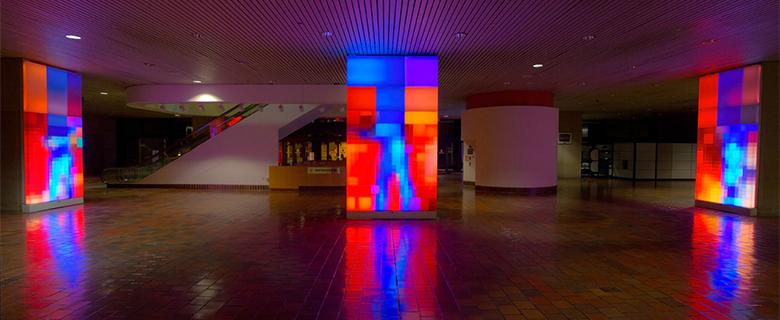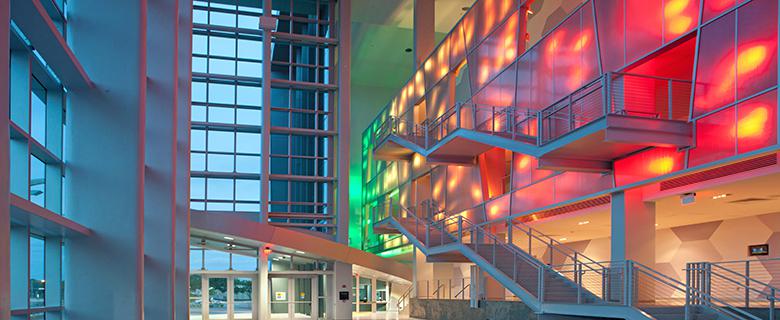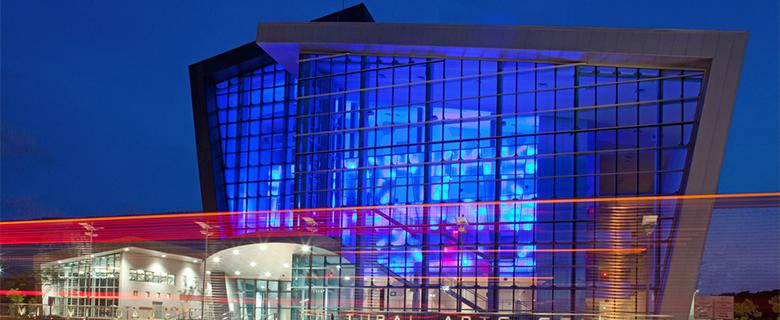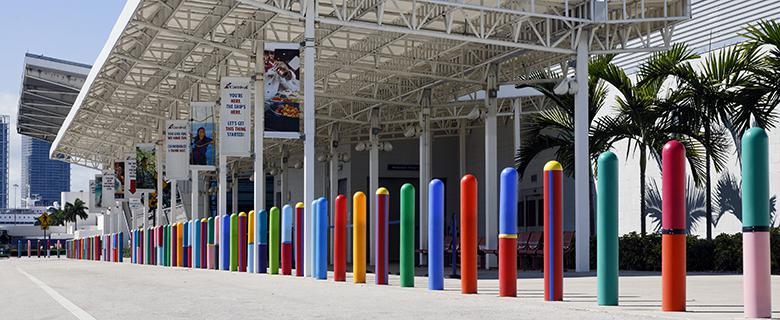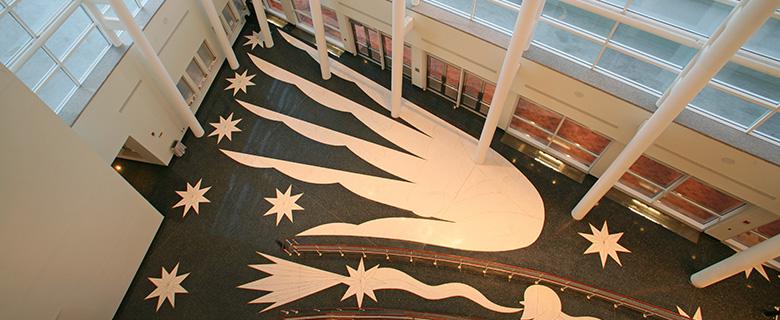1. Why is the new theater planned for approximately 300 seats when the prior auditorium held 1150?
The proposed theater is anticipated to have approximately 300 seats, as specified in the Business Plan that is part of the lease with the State, and which aims to provide a financially sustainable model for the operator. It is significant to note that the building’s original theater auditorium seating was designed well before today’s more rigorous accessibility and egress codes and that the silent movie house was not designed to take into consideration necessary theatrical elements such as sightlines and lighting positions. A theater of this size creates intimacy and an “electric” sense of immediacy between artists and the audience, in keeping with what the theater’s future operator GableStage provides in their current venue. A larger theater requires a larger (taller) parking garage that would loom over the residential neighborhood and significantly increase traffic, while also facing increased competition from like-sized venues that already exist throughout Miami-Dade County (Adrienne Arsht Center (2,400, 2,200seats); the Olympia Theater (1,567 seats); the Dennis C. Moss Cultural Arts Center (990 seats); Manuel Artime Theater (880 seats); Miami-Dade County Auditorium (2,372); and Actors’ Playhouse (600), to name a few.
2. What will happen to the historic elements of the original Playhouse?
The historic front building is being faithfully restored to its original Kiehnel and Elliott architecture including restoring the original 1927 exterior paint color and architectural features, as well as the original use of small store-front spaces on the ground floor, designed to be pedestrian-friendly. Certain key architectural features that the conservators deemed salvageable from the auditorium (double proscenium arch, Solomonic columns, fish fountain, and decorative grilles) have been carefully removed by professional arts conservators and are being preserved and integrated into the new theater.
3. Who is GableStage and why are they qualified to operate the theater?
GableStage is an award winning nonprofit regional theater company that celebrates Miami’s theatrical talent by hiring local actors and theater professionals, has a long-established track record for offering educational and outreach programs and for helping smaller, up and coming theater companies develop their work. Since 2023, GableStage has received eight Carbonell Awards (for a total of 72), including two coveted Outstanding Production awards. In 2023 and 2024, GableStage was voted Best Theatre Company by Miami New Times and Coral Gables Magazine. In 2025, GableStage was the Miami New Times “Reader’s Choice” Best Theatre Company. The management and operating agreement with GableStage, approved by the Miami-Dade County Board of County Commissioners, is available here: http://www.miamidade.gov/govaction/matter.asp?matter=151074&file=false&yearFolder=Y2015
4. What is the current status of construction and when will it be complete?
Work began on Phase I of the project, which includes the extraction and preservation of historical elements, asbestos abatement, selective demolition, and stabilization of the front building, in Spring 2025 with the award of the competitive solicitation for a general contractor to John Bell Construction, and the issuance of a City of Miami permit on April 15, 2025. At the same time, the final plans, inclusive of the parking garage, are being updated and completed by the project architect, Arquitectonica International inc., and are anticipated to be submitted for City of Miami regulatory review starting in late 2025/early 2026. A solicitation for a general contractor for the balance of the project, including the full rehabilitation of the front building and the construction of the theater and support components, the garage building and all site improvements, is scheduled to take place in early 2026. Partial project completion is anticipated for the 100th anniversary in 2027, with full commissioning by 2028.
5. How is the project being funded?
The Project is funded through a variety of sources, including the Building Better Communities General Obligation Bond, County Infrastructure Investment Program, Convention Development Tax, revenue generated from the Playhouse surface lot, and a grant from the Knight Foundation. Additionally, the Miami Parking Authority is committed to funding the development costs of the garage structure, with support from the Coconut Grove Business Improvement District.
6. How does the project intend to contend with impacts to the neighborhood, and traffic in particular?
The size, scope, and layout of the project are focused on appropriately addressing traffic impacts to the West Grove / Little Bahamas residential area and providing connectivity to Main Highway. The County has attended public meetings in Village West/Little Bahamas and looks forward to continuing to collaborate with Village West community leaders. Whereas the prior structure has traditionally not been welcoming to the surrounding neighborhood, the project will change that through the following:
• Reduce the number of vehicles entering and leaving the theater at any one time (300 seats vs. 1150 seats)
• Use curb cuts and signage to direct vehicles servicing the site to enter and turn deep within the site and to exit back onto Main Highway to deter heavy traffic through the residential neighborhood
• Situate the entrance and exiting from the garage to occur along Main Highway, similar to how the surface parking is currently accessed
• Provide pedestrian connectivity through the campus-style series of buildings (theater, front building, and garage building) for Village West/Little Bahamas residents to access Main Highway
7. What commercial development is included? Will this be a mall?
There is no “mall” nor “hotel development” planned for the site; instead, the historic front building is being faithfully restored to its original Kiehnel and Elliott architecture including the original use of small store-front spaces on the ground floor. There are no large-scale commercial retail spaces planned for the property. The ground floor of the historic front building will consist of small storefronts consistent with the scale and size of those that were present in 1927. Office space is planned for the upper levels fronting Main Highway of both the front building and the garage building. The primary focus continues to be to bring theater back to the heart of Coconut Grove, while providing a fiscally responsible model that ensures its long-term success.
8. Will there be community benefits? What benefits is the Playhouse expected to bring to the surrounding neighborhood and the community at large?
With respect to the surrounding neighborhood, the plan includes a promenade connecting the West Grove/ Little Bahamas and the broader community to the Coconut Grove business district, a pocket park and beautiful landscaping that will create a pedestrian-friendly environment. This approach unifies the West Grove/ Little Bahamas areas with downtown Coconut Grove, replacing chain link fences and surface parking lots with ways for people to cross through the site and enjoy the outdoor spaces. With respect to the greater community at large, the theater is anticipated to offer educational and training programs in the arts that offer students career opportunities – not only “on stage” but also the professional careers that exist “behind the scenes” in production, design, and technical wizardry. GableStage and FIU, the co-lessee, already have a track record and commitment to do this, especially for children in the West Grove/ Little Bahamas neighborhood. Spaces such as the studio theater/ rehearsal hall space are affordable and accessible ways to encourage community use (e.g., safe after school classes and homework sessions for children using its Wi-Fi; community meetings; classes like Pilates and yoga; etc.).
9. Why has the process taken so long?
Following its closure due to financial difficulties in 2006, the Coconut Grove Playhouse property was reverted by and returned to State of Florida ownership. Florida International University and Miami-Dade County in consultation with GableStage prepared and submitted a detailed Plan for returning theater to Coconut Grove to the State of Florida. The State of Florida through the Florida Cabinet and Governor unanimously approved the plan and a lease in2013 with Florida International University and Miami-Dade County as co-lessees. As a condition of the lease, the County also had to negotiate and settle numerous encumbrances on the title. Subsequently, a competitive selection process for architectural, engineering, and specialty consultant services was conducted, concluding with the selection in 2015 of a team led by Arquitectonica International Inc., which includes historic preservation architect Jorge Hernandez among a stellar list of consultants and specialists. The team has been engaged in conducting historical research, providing master planning services, and developing schematic design, design development; and construction documents. The design plans have been reviewed by multiple City of Miami regulatory bodies including:
• Coordinated Review Committee
• Urban Design Review Board (voted unanimously (6-0) on February 21, 2018),
• Planning, Zoning and Appeals Board (PZAB) approved the County’s application for zoning exceptions on November 7, 2018 by an 8 to 3 vote
• Historic Environmental and Preservation Board (HEPB) - a Certificate of Appropriateness (COA) was approved by the City of Miami Commission on May 23, 2019 via City of Miami Resolution R19-0169.
The project has also been delayed due to several legal challenges relating to the necessary City approvals, including multiple appeals before the Circuit Court Appellate Division and the Third District Court of Appeal.
10. How can the public stay informed or get involved?
Updates are regularly posted on the Miami-Dade Department of Cultural Affairs website. Community meetings have been and will continue to be held to gather feedback and address concerns.
For historic FAQ responses, please click here.
